#gymnothorax
Explore tagged Tumblr posts
Text

A green moray eel (Gymnothorax funebris) at Clifton Gardens, NSW, Australia
by John Turnbull
#green moray#green moray eel#moray eels#eels#bony fish#fish#gymnothorax funebris#gymnothorax#muraenidae#anguilliformes#actinopterygii#chordata#wildlife: australia#wildlife: oceania
182 notes
·
View notes
Text
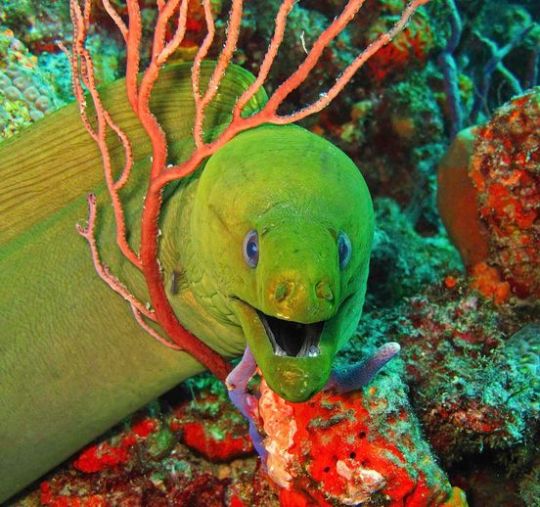
Green Moray (Gymnothorax funebris), family Muraenidae, off the coast of southern Florida, USA
photograph by @dohertyphotography
793 notes
·
View notes
Text
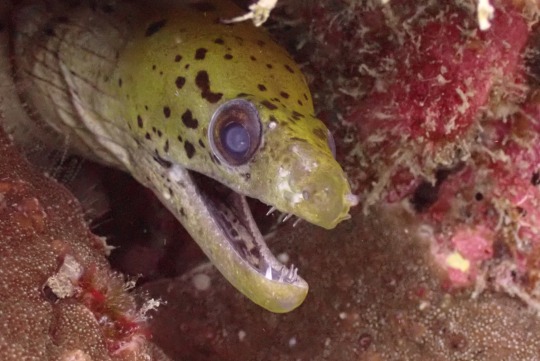
Gymnothorax fimbriatus or the Fimbriated moray.
This little guy poked his head out to come say hello. Interestingly enough, I don’t think that glassy colouration to the eye is normal, my theory is that it has been damaged from a disease or parasite. Would love to hear more from someone more knowledgeable :)
43 notes
·
View notes
Text
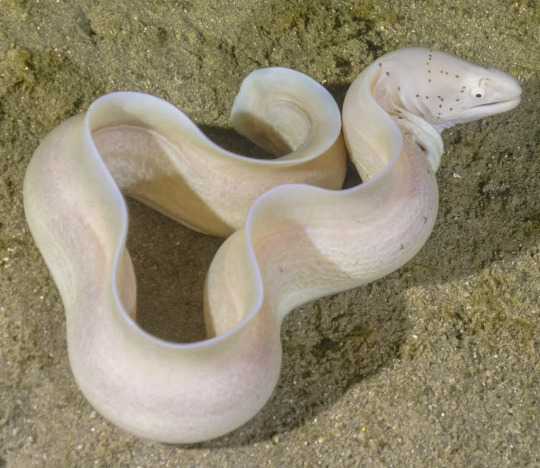
Full body view of a geometric moray (Gymnothorax griseus) shot during a night dive in Ras Muhammad National Park, Red Sea, Egypt.
6K notes
·
View notes
Text

ハワイウツボとかいうメチャカワウツボがたくさんいて嬉しい
@鳥羽水族館
I'm happy to see so many cute moray eels.
@Toba Aquarium
65 notes
·
View notes
Text
- Goldentail Moray (Gymnothorax miliaris)
- Pacific Banana Slug (Ariolimax columbianus)
- Ball Python (Python regius)
- Polillo False Gecko (Pseudogekko smaragdinus)
- Banded Linsang (Prionodon linsang)
- Budgerigar (Melopsittacus undulatus)
Mods are asleep, post bananimals




#animal identified#fish#eel#goldentail moray#gymnothorax miliaris#mollusc#slug#bug#pacific banana slug#ariolimax columbianus#reptile#snake#ball python#python regius#gecko#lizard#polillo false gecko#mammal#pseudogekko smaragdinus#banded linsang#prionodon linsang#bird#parrot#budgerigar#melopsittacus undulatus
21K notes
·
View notes
Text

I fucking love eels so I'm so fucking stoked that there are gear morays in Guilty Gear! Sweet.
Closeup of the cute guy

#blurred out my avatar cause this isn't about her lol#has someone ripped the fishing sprites? I hope so! I love the inclusion of both real and made-up sea creatures#I know this is a gear with moray traits so I shouldn't adscribe any resemblance to proper real species HOWEVER idc:#mostly reminds me of a giant moray (Gymnothorax javanicus) but ig the colour is more like a green or yellow moray (Gymnothorax funebris and#Gymnothorax prasinus. respectively) giant morays especially are noted to live in shallow waters like this gear#fun fact abt morays: they're extra slimy thanks to their high goblet cell density (which fsr reminds me of how humans have the most sweat#glands out of primates. they don't have the same function though) and in at least green morays (idk the others) gives them their colour.#they'd be darker underneath. anyways#gameventure tag2b named#dusting off that tag with a post. what a post!
1 note
·
View note
Text
A true freshwater moray
Tiger or manytoothed moray eels, "Gymnothorax" polyuranodon, are so far the only moray eel species verified to habitually inhabit freshwater environments as adults. Of course their entire life cycle includes a spell in the ocean, which appears to be necessary to anguilliforms, but this is currently the only moray species known to spend its adult life in freshwater.
Adult eels of this species inhabit almost solely coastal freshwaters, both still and moving, so it is considered to be a true freshwater moray, and not an estuarine form that visits upstream. Although it inhabits estuaries also, it is about twice as common in pure freshwater, and avoids strongit brackish salinities. Technically, their life cycle is catadromous, meaning they begin life out at sea, before migrating upstream with age.
Despite the fearsome reputations of morays, the tiger moray has evolved as a specialized, probing forager of small prey, which are probably arthropods. As a consequence, they are safe sharing an aquarium with surprisingly small fishes, because their teeth are small, relative to their own jaws, and their heads have similarly become small relative to their overall length.
The aquarium pH ought to be 7 to 8, and their diet should be meaty morsels, provided in suitably cut sizes. Because these eels are found far upstream in natural environments, the addition of aquarium salt is entirely unecessary, although the low end of brackish salinities, such as 1.005, should not harm these eels, either. As adults, they do not dwell in the sea, so they should never be regarded as marine fishes.
However other details of their biology and care, do match those of the better known marine.morays, such as their nocturnality, and their need to frequent hiding places by day. Temperatures should be 24 to 28 degrees, and they are certainly flourishing in aquariums, cared for as I have described above.
#Gymnothorax polyuranodon#tiger moray#freshwater moray eel#oddballs#predator fish#aquarium eels#manytoothed moray
0 notes
Text
Wet Beast Wednesday: moray eels
This week on Wet Beast Wednesday I'll be going over something amazing, a fish with a sense of morality. You see, the moral eel is known for, what... I think I'm reading this wrong. Oh, MoRAY eel, not moral. Well this is awkward. Hang tight, I need to go redo my research.
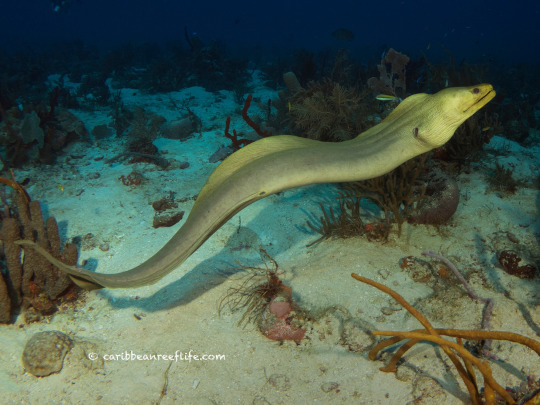
(Image: a green moray (Gymnothorax funebris) swimming outside of its burry, with its whole body visible from the side. It is a long, slender fish that looks a bit like a snake. A long fin starts just below the head and continues down the length of the body. The body is arranged in a wave pattern. It has a pointed snout and small eyes. Its body is a yellow-green color. In the background is the sandy seafloor, dotted with various sponges and corals. End ID)
Moray eels are true eels, meaning they are in the order Anguiliformes. Yeah, I did wolf eels, electric eels, and lamprey eels before I got around to actual eels. There are over 200 known species of moray eel in 15 genera. Like other eels, they are elongated bony fish with extra vertebrae and reduced fins. Moray eels have fewer fins than most eel species, only having a dorsal, anal and tail fin that merge together and run down the back of most of the body and underneath portion of it. They achieve motion by undulating this long fin and sometimes undulating the rest of the body as well. Moray eels aren't the fastest of fish, but they can swim backwards, something almost no fish can. The head has a long snout with wide jaws. Most species have long fangs used to grab onto prey, but a few species are adapted to eat hard-shelled prey and have molar-like teeth to crush through shells instead. Probably the coolest feature of morays are the pharyngeal jaws. This is a second set of jaws located in the back of the mouth. When the eel bites onto prey, the jaws can be shot forward to grab the food and help pull it into the throat. While lots of fish have pharyngeal jaws, morays are the only ones who can extend their pharyngeal jaws forward and use them to grab prey. Morays have smooth, scaleless skin that is often patterned to provide camouflage. The skin is coated in mucus that provides protection from damage and infection. In some species, the mucus can be used to glue sand together to help reinforce burrows. Morays lack lateral lines, a system of organs found in most fish that senses changes in water movement. Their sense of smell is their primary sense. The size of morays varies between species. The smallest species is the dwarf moray eel (Gymnothorax melatremus) which reaches 26 cm (10 in) long. The largest species by mass is the giant moray eel (Gymnothorax javanicus) which can reach 3 meters (10 ft) and 30 kg (66 lbs) while the longest species is the slender giant moray (Strophidon sathete), the longest known specimen of which measured in at 3.94 m (12.9 ft).
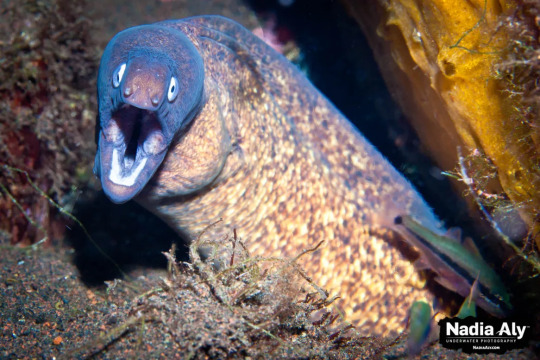
New reaction image
(Image: a giant moray (Gymnothorax javanicus) emerging from a burrow. It is brown and mottled with yellowish patches. Its head is pointed at the camera and it's mouth is wide open, aming it look shocked. End ID)

(Image: an anatomical diagram of the skeleton of a moray eel emphasizing the pharyngeal jaws and the muscle attachments. End ID. Art by Zina Deretsky)
Moray eels are found throughout the Atlantic, Pacific, and Indian oceans. Different species are found in different temperatures and depths, though most species live in relatively shallow, warm water. Several species can live in brackish water and a few will swim upriver and live for a time in fresh water, though there do not appear to be any species that live their entire lives in fresh water. Morays are ambush predators who rely on the element of surprise. They live in small, tight places such as holes in coral, gaps between rocks, or sandy burrows. When prey passes, the eel can lunge out and grab it. Unlike most fish, the eel cannot use suction feeding due to the shapes of their mouths. They have to rely on lunging froward and catching prey with their mouths. Their mouths are adapted in shape to push water to the sides. This reduces water resistance and avoids creating a wave that could push prey away from the eel. If an eel catches prey that cannot be swallowed whole, it will tie itself in a knot while biting on to the food. By pulling its head through the loop, the eel can rip the food into bite-sized pieces. Spending most of their times in burrows also provides protection from predators, especially in juveniles or smaller species. At night, the eels will come out of their burrows to hunt sleeping prey while the larger predators are asleep. Giant morays have also been seen engaging in interspecies cooperative hunting with roving coral groupers (Plectropomus pessuliferus). The eels can fit into small crevices the groupers can't to flush prey into the grouper's path while catching their own. Morays are mostly solitary species and many can be territorial. They are known to be shy and will retreat into their burrows if they feel threatened. They are also curious and many species are quite intelligent.
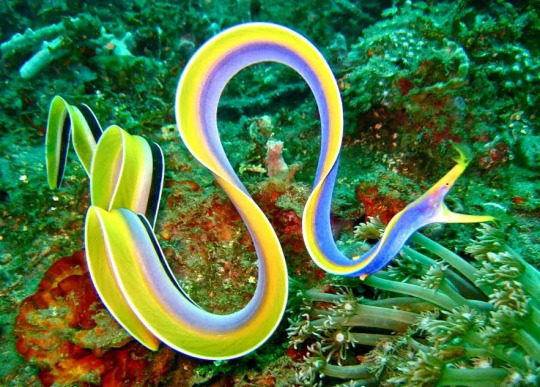
(Image: a male ribbon eel (Rhinomuraena quaesita) on a coral reef. It is a very long and slender eel with its body curved in many waves. It is brightly colored, with a blue-purple body, yellow fin and face, and a long black and white stripe running down the back half of the body. On the nostrils are two feather-like structures. End ID)
Morays reproductive strategies are poorly known and differ based on species. While many species seem to have no set mating season and will reproduce whenever they can, others will mate at the same time every year. Some species seem to have dedicated spots to lay their eggs and a few are believed to be anadromous, meaning they travel from the sea to fresh water to spawn. Meanwhile, some of the species that spend a lot of time in fresh water are catadromous, meaning they return to sea to mate. Females will lay their eggs and the male fertilize them. After this, they depart, providing no parental care. As with all true eels, moray eels begin life as leptocephalus larvae. This type of fish larvae is notable for its resemblance to a simple, transparent leaf with a head on one end. These larvae are unique and poorly understood, despite being the larval stage of a lot of different species of fish. They are unusually well developed for larvae, capable of active swimming and generally living life. In fact, some particularly large leptocephalus larvae were initially mistaken for adult fish. They feed mostly on bits of drifting organic material called marine snow and can remain in the larval stage for up to 3 years, with those in colder conditions usually taking longer to metamorphose. All leptocephalus larvae start out with no sex organs, then develop female organs, then develop male ones, becoming simultaneous hermaphrodites. They will ultimately become eith male or female and it is likely that environmental factors are the main determining factor. During metamorphosis into a juvenile, the leptocephalus can reduce in size by up to 90%, resulting in the juvenile being smaller than the larva. The process of maturation is poorly understood, but it seems that most morays will be sexually mature by three years of age.

(Image: multiple photos of a particularly large leptocephalus larva (not sure what species). It is a translucent organis, wth a body shaped like a very long leaf, narrow at both ends. In the frint is a very tiny head. End ID)
Morays are shy and generally avoid humans. Though some cultures have hunted them for food, they are often not considered a particularly good food source. Many species have high levels of chemicals called ciguatoxins in their bodies, which can lead to a condition called ciguatera fish poisoning if eaten. The largest threat to morays is habitat loss. This is especially true for the many species that live in coral reefs, which are in increasing danger due to global warming. Attacks on humans are rare and usually happen as a response to a human sticking their hand in the eel's burrow. Some of the large species could cause significant damage with a bite. Some species, usually the smaller ones, are found in the aquarium trade, thought they are not good pets for beginners as even the smallest morays are still large for aquarium fish and have some specific requirements. The curiosity many morays have has led to some becoming familiar with and even friendly to humans, often the result of feeding them. They can recognize individual humans and remember them over the course of years. Aquarium employees sometimes report that the eels will come to nuzzle and play with them and have personalities like dogs. Marine biologists and professional SCUBA divers Ron and Valorie Taylor befriended a pair of eels they named Harry and Fang at the Great Barrier Reef who would remember them and come out to visit them year after year.
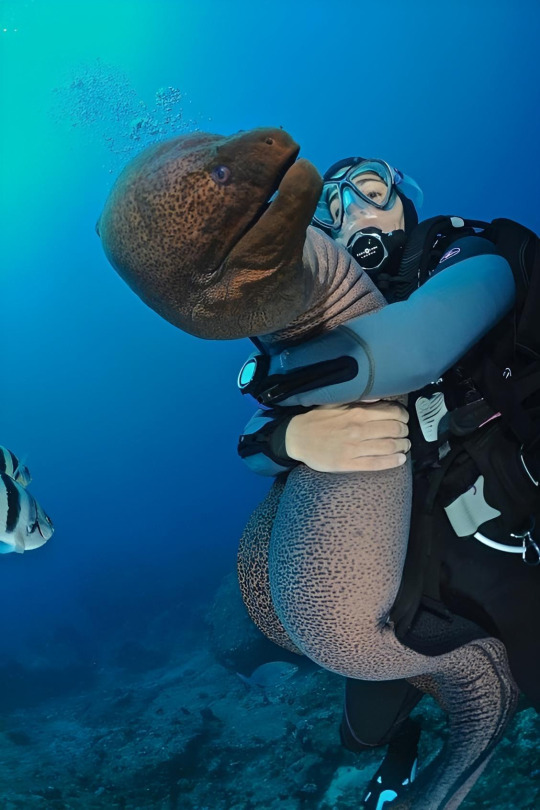
(Image: a SCUBA diver hugging a large, brown moray with black spots. End ID)
youtube
(Video: A shot video showing Valeria Taylor and a moray eel she befriended)
youtube
(Video: the song "That's a Moray", a parody of the song "That's Amore" by Dean Martin)
#wet beast wednesday#i accidentally typed moron eel more than once#moray eel#eel#anguiliformes#fish#bony fish#fishblr#fishposting#eelposting#marine biology#biology#ecology#zoology#animal facts#informative#image described#that's a moray#educational#Youtube
1K notes
·
View notes
Text
this world eel day we need to reflect on the eels that are endangered and think about why that is. here are some endangered eels that may be local to you:
Critically endangered:
European eel

Found throughout europe and the northern coast of africa, this eel is under continuous decline due to overfishing, various human actions changing or destroying waterways (commercial development, mining, roads and railways, logging, dams etc), pollution, and of course- climate change.
Endangered:
New Zealand longfin eel

Found in well. new zealand. this eel is threatened by modifications to existing water systems, pollution, and climate change.
Japanese eel

Found in east asia, this eel is heavily farmed for food but the population in the wild is decreasing. It is threatened not only by fishing, but also housing development, mining, human modification of existing waterways, pollution and climate change.
American eel

Lives in freshwater and estuaries along the eastern coast of north america. It is threatened by pollution, mining, human modification of existing water systems, climate change, fishing, and invasive species.
Gymnothorax parini
(no image available), a moray eel that lives in the west indian ocean. It is threatened by commercial fishing occurring in its limited range.
They may not be the most photogenic or traditionally "cute" creatures, but eels are so important to the environment, from being important predator species to being sources of food for birds and larger fish. if we lose eels we lose a lot more.
709 notes
·
View notes
Text
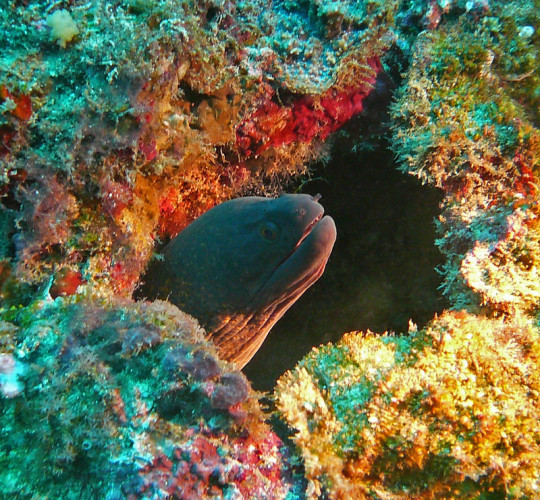
A giant moray eel (Gymnothorax javanicus) in Bunaken National Park, Sulaewsi, Indonesia
by jaffles
#giant moray#moray eels#eels#fish#bony fish#gymnothorax javanicus#gymnothorax#muraenidae#anguilliformes#actinopterygii#chordata#wildlife: indonesia#wildlife: asia
176 notes
·
View notes
Note
Can I have a fish pleas e :)
E el

You get a Stout Moray
Gymnothorax eurostus
152 notes
·
View notes
Text

Eliot Rotford
Green Moray (Gymnothorax funebris) on Barracuda Reef in Fort lauderdale Florida
189 notes
·
View notes
Text

Geometric moray (Gymnothorax griseus), Red Sea, Egypt
502 notes
·
View notes
Photo


思い出のたくさんたくさん詰まった東海大学海洋科学博物館の一般営業最終日で、ほぼ泣きながら見ていたのですが、この子が笑わせてくれました
東海大学海洋科学博物館のみなさま、長い間ありがとうございました
ありがたいことに今後は予約を入れれば一階のみ見られるということで、これからも折を見て伺いたいと思います
@東海大学海洋科学博物館
This aquarium was closed in March 2023. I like here when I was a kid. I have many many many memories of this aquarium, and I learned lots of things.
In final day, I explore during I cried....but this moray made me laugh!
MSM, thank you so much for running it for long time.
(From now on, if we make a reservation, we can see some tanks.)
@Marine Science Museum, TOKAI University
17 notes
·
View notes
